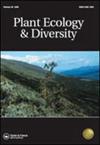树木和森林中的干旱-枯枝死亡难题
IF 1.6
4区 生物学
Q2 PLANT SCIENCES
引用次数: 12
摘要
摘要背景:气候变暖正在加剧全球干旱压力。蒸发需求增加和土壤水分可利用性下降的长期趋势叠加在严重干旱期间。这些罕见的极端干旱引发了森林枯死,导致生产力下降和死亡率上升,通常是小规模的(枯死热点),但影响了世界各地的生物群落。目的:综述和讨论干旱引起森林枯死的驱动因素、模式和机制。方法:我回顾了与干旱期有关的森林枯死和树木死亡的研究,重点是预测枯死的工具。结果:有几种机制被描述为死亡的生理驱动因素,包括液压故障和碳饥饿,但基于液压的模型几乎没有显示出死亡和死亡的预测能力。树木活力的实地指标,包括树冠落叶和含水量的变化,与树木功能的替代指标(树木年轮生长、木材解剖、树木年轮δ13C或δ18O组成)相结合,可以改善森林枯死的预测,或至少提供树木即将死亡的预警信号。结论:干旱引起的死亡和死亡是一种缺乏足够预测能力的预测工具的现象。应使用树木活力、生长和功能的替代品来建立更准确的树木死亡模型,以应对与干旱有关的极端气候事件。在这里,我主张将这些替代品结合起来并进行比较,以更好地预测森林枯死。本文章由计算机程序翻译,如有差异,请以英文原文为准。
The drought‒dieback‒death conundrum in trees and forests
ABSTRACT Background: Climate warming is amplifying and exacerbating drought stress worldwide. Long-term trends of increasing evaporative demand and decreasing soil moisture availability occur superimposed on severe spells of drought. These rare, extreme droughts have triggered episodes of forest dieback that have led to reduced productivity and rising mortality rates, usually at small scales (dieback hotspots), but affecting biomes worldwide. Aims: This review summarizes and discusses the drivers, patterns and mechanisms of forest dieback caused by drought. Methods: I review studies on forest dieback and tree death linked to dry spells with a focus on tools to forecast dieback. Results: Several mechanisms have been described as physiological drivers of dieback, including hydraulic failure and carbon starvation, however hydraulics-based models have shown little predictive power of dieback and mortality. Field proxies of tree vigour, including changes in canopy defoliation and water content, combined with surrogates of tree functioning (tree-ring growth, wood anatomy, tree-ring δ13C or δ18O composition) may improve predictions of forest dieback or at least render early-warning signals of impending tree death. Conclusions: Drought-induced dieback and mortality are concerning phenomena which lack forecasting tools with sufficient predictive power. Surrogates of tree vigour, growth and functioning should be used to build more accurate models of tree death in response to extreme climate events linked to drought. Here, I argue for combining and comparing those surrogates to better forecast forest dieback.
求助全文
通过发布文献求助,成功后即可免费获取论文全文。
去求助
来源期刊

Plant Ecology & Diversity
PLANT SCIENCES-
CiteScore
3.30
自引率
0.00%
发文量
26
审稿时长
3 months
期刊介绍:
Plant Ecology and Diversity is an international journal for communicating results and novel ideas in plant science, in print and on-line, six times a year. All areas of plant biology relating to ecology, evolution and diversity are of interest, including those which explicitly deal with today''s highly topical themes, such as biodiversity, conservation and global change. We consider submissions that address fundamental questions which are pertinent to contemporary plant science. Articles concerning extreme environments world-wide are particularly welcome.
Plant Ecology and Diversity considers for publication original research articles, short communications, reviews, and scientific correspondence that explore thought-provoking ideas.
To aid redressing ‘publication bias’ the journal is unique in reporting, in the form of short communications, ‘negative results’ and ‘repeat experiments’ that test ecological theories experimentally, in theoretically flawless and methodologically sound papers. Research reviews and method papers, are also encouraged.
Plant Ecology & Diversity publishes high-quality and topical research that demonstrates solid scholarship. As such, the journal does not publish purely descriptive papers. Submissions are required to focus on research topics that are broad in their scope and thus provide new insights and contribute to theory. The original research should address clear hypotheses that test theory or questions and offer new insights on topics of interest to an international readership.
 求助内容:
求助内容: 应助结果提醒方式:
应助结果提醒方式:


